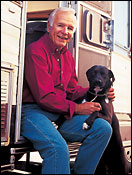Nobody rich and famous is out here. “This is where ‘main-street’ Virginia City is buried – the bartenders and shopkeepers, the dishwashers and cooks, miners and their families – the people who made others rich and famous.”
Candace Wheeler and I were standing at a break in a low stonewall that is the entrance to the cemeteries of Virginia City. At one time there were 15 cemeteries with their inhabitants clustered by race, religion or country of origin. Now only eight are discernible.
It’s the last day of October. A chilly wind carries a few flakes left from the snow flurry that dusted the barren hills above town early this morning. At an elevation of 6,220 feet, it’s time for winter to start showing itself.
As president of the Comstock Cemetery Foundation, Candace has spent considerable time studying these cemeteries. All told, their population now exceeds that of all of Storey County, of which Virginia City is the county seat.
“If you look around you’ll find out how the people lived – how they felt about themselves and about each other. Epitaphs on grave markers, both in words and symbols, tell a great deal. For one thing, they tell us that people here died young. Granted, this was not exactly a retirement community. None were native to the West except for infants, of course. They came from Ireland, Wales, Italy, Germany, China and parts of the Eastern United States. Women buried here apparently died mostly in childbirth.”
Stonecutters who did the handwork on tombstones didn’t come here until 1880. Prior to that, most grave markers were fashioned of whatever lumber was available, and there wasn’t much. Many a spring wagon was broken up and the wood used to make a coffin and the grave marker.
The Comstock Lode, rich veins of silver discovered in the hills of western Nevada in 1859, gave the town unequaled prosperity. It eventually poured an estimated $400 million into our young westward-expanding nation. Some of it paid for the Victorian splendor of San Francisco, and even more to finance the Union Army during the Civil War.
In the late 1800s, 40,000 people lived in and around Virginia City, known as the Comstock. For 25 glorious years, it was the leading city in Nevada and the brightest and most important settlement between Denver and San Francisco. It had the only elevator this side of Chicago, if you don’t count San Francisco.
Notable residents include Mark Twain, who worked as a young reporter for 22 months on The Territorial Enterprise – Nevada’s first newspaper.
Samuel Clemens had just taken the pen name of Mark Twain, when in January 1863, he wrote about a fistfight here on C Street. He ended it: “We pine for murder – these fist fights are of no consequence to anyone.”
C Street, Virginia City’s main drag, is more family-friendly these days. Its wooden sidewalks rise and fall like a hill-country road under signs for the “Bucket of Blood,” “Grandma’s Fudge,” the “Silver Queen Hotel,” the “Red Dog Saloon” and, of course, “Mark Twain Books.”
Virginia City is the largest historic district in the United States; still it’s a functioning town, albeit with an 1850 veneer.
Deer, now more numerous than ever, browse the quiet, arid mountainside on which Virginia City is built. Coyotes still stalk rabbits on the perimeter of town and through its cemeteries.
Welcome to America’s Outback.
Bill’s e-mail address: [email protected]

